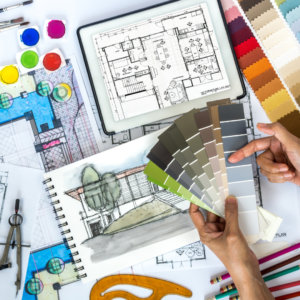 In the digital age, where convenience often trumps all, the allure of online options and AI tools for interior design projects is undeniable.
In the digital age, where convenience often trumps all, the allure of online options and AI tools for interior design projects is undeniable.
Yet, working with a human interior designer remains a timeless and irreplaceable advantage amidst the plethora of virtual solutions. Let’s explore the keys to and benefits of successfully collaborating with a human interior designer.
Key 1: Clear Communication and Expectations
Effective communication is vital for a successful interior design project. Before diving in, clearly discuss your preferences, budget, and project scope with your designer. Setting clear expectations helps avoid misunderstandings and ensures the final result aligns with your vision.
Key 2: Budget Planning and Management
Understanding the cost implications of your design choices is crucial. Your designer should provide a detailed budget that includes all expected expenses, transparent fee structures, and a plan for handling changes or unexpected costs.
Key 3: Collaboration and Flexibility
Collaboration is essential for a successful partnership. While it’s important to communicate your preferences and needs, be open to your designer’s professional advice and creative solutions. Collaboration involves trusting the designer’s expertise while staying involved in decision-making.
Benefits of a Human Interior Designer
The benefits of working with a human designer in interior design are undeniable. Beyond the tangible aspects of material selection and spatial understanding, the personal connection forged through direct collaboration fosters a sense of trust and confidence in the design process. With a human designer, you’re not just a client but a valued collaborator, actively shaping every aspect of your living space to reflect your unique personality and style.
Benefit 1: Personalized Attention
In-person designers offer personalized attention tailored to your unique preferences, lifestyle, and vision. Direct interaction allows a deeper understanding of your needs, ensuring that the final design reflects your personality and style.
Benefit 2: Collaboration and Communication
Face-to-face interactions facilitate real-time collaboration and seamless communication channels. Whether brainstorming ideas or discussing project milestones, direct interaction fosters engagement and understanding between you and your designer.
Benefit 3: Spatial Understanding
In-person designers have the advantage of physically visiting your property, allowing them to assess its layout, lighting conditions, and architectural features firsthand. This intimate knowledge enables them to devise design solutions that maximize your space’s potential.
Benefit 4: Material Selection
The tactile experience of selecting materials enhances the design process. Human designers allow you to see, touch, and feel samples of fabrics, finishes, and furnishings, helping you make informed decisions.
Benefit 5: On-Site Problem Solving
Despite meticulous planning, unforeseen challenges will likely occur during a project. Human designers excel at on-the-spot problem-solving, ensuring the project stays on track and delivers results exceeding your expectations.
Benefit 6: Customization and Detailing
In-person designers deliver customized solutions tailored to your requirements. From conceptualization to execution, they oversee every aspect of the project, ensuring that every detail is meticulously curated to reflect your taste and style.
AI Can’t Replace the Human Interior Designer
While online options and AI tools offer convenience, they cannot replicate the depth of understanding, personalization, and attention to detail that come with working directly with an in-person interior designer.
There is power in face-to-face collaboration, and by establishing a strong partnership with your designer, you can unlock the full potential of your interior design project.



